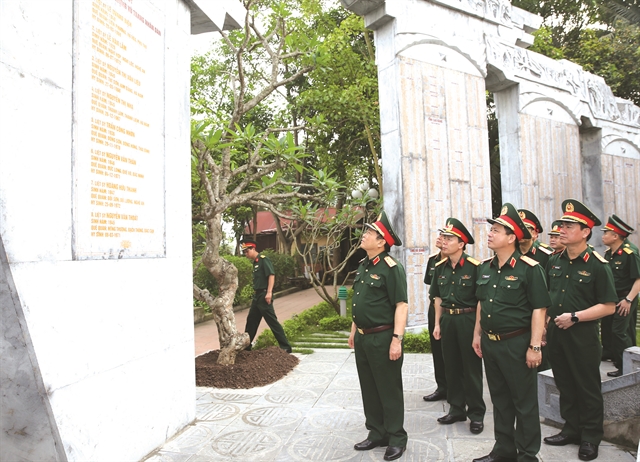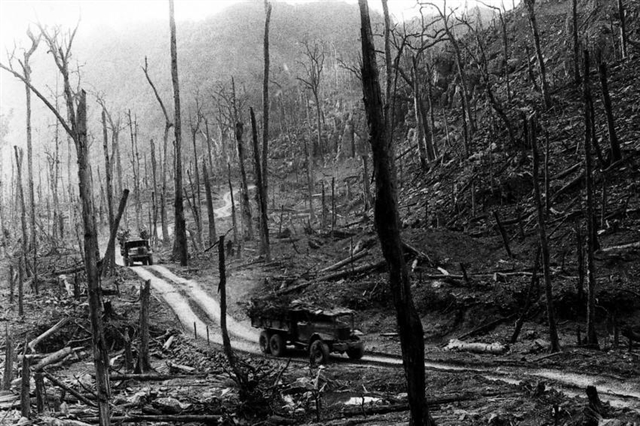Hồ Chí Minh Trail: 60 years and beyond
Over 16 years, engineers, soldiers and volunteers built 20,000km of roads, 1,400km of oil-and-gas pipeline, 3,140km of hidden paths for vehicles to pass during the daytime, plus thousands of smaller bridges and drains. VNA/VNS Photo Văn Sắc
.
The Hồ Chí Minh Trail proved a vital lifeline on the country’s path to reunification, but keeping it open came at a high price
By Nguyễn Mỹ Hà*
The song “East of Trường Sơn Calling West” has become a soul-searching tribute to those who trekked through Việt Nam’s deepest jungle to unify the country. Starting in 2016, the live-televised show has brought together thousands of former soldiers, volunteers and students from the North who volunteered to go South and students who opposed the American war at that time to share stories and memories and recall those who fell for their country.
This years, 350 veterans, researchers and guests met in Đăk Nông at a national conference titled “From Trường Sơn to Hồ Chí Minh Trail — Symbol of the Will for Nation’s Reunification” to commemorate its 60th anniversary. During the conference, military historians, retired generals and strategists reviewed the key points, tactical battles and important logistical decisions to keep the trail safe from enemy bombs, artillery shellings or simply tropical storms and flash floods.
ADS by Cloud 9:
.
– SPACE RESERVE FOR YOUR ADVERTISEMENT –

Trường Sơn — Hồ Chí Minh Trail
Sixty years ago, Gia Nghĩa Town was the meeting point between the North and South on the Trường Sơn Trail, hence the reason for holding the conference there.
In his opening speech, Senior Lieutenant General Lê Chiêm said that 60 years ago, the Politburo of Việt Nam’s Communist Party and President Hồ Chí Minh decided to open a strategic transportation link to connect the North to the battle front in the South. This decision showed national determination to fight and win the war.
ADS by Cloud 9:
.
– SPACE RESERVE FOR YOUR ADVERTISEMENT –

.jpg)
.
.
“What made the Trường Sơn – Hồ Chí Minh Trail so legendary was not only that it was vital to our desire to reunify our country, but also a symbol for the mutual friendship between the peoples of Việt Nam, Laos and Cambodia,” Deputy Defence Minister Lê Chiêm told the audience.
He added that in retrospect, historians now can shed new in-depth understanding of the effects of the trail to extract precious lessons for further study and to rebuild the country and defend it in the future.
Built, repaired and maintained for 16 years until the day the South was liberated and the country was reunified, the network of dirt roads and beaten mountain paths over rivers and streams served as a strategic transportation link but also another front line for soldiers from the North and bombardments dropped from above by the US forces. It was where the power of goodwill and tactical approach won over the power of modern technology and weaponry.
.
ADS by Cloud 9:
.
– SPACE RESERVE FOR YOUR ADVERTISEMENT –

The old saying “ There is no path, paths are made by walking” could not be more true than in this case. Trường Sơn, or the Long Mountain Range, begins from the northern province of Hòa Bình, crosses part of Việt Nam’s central region, runs through lower Laos and eastern Cambodia, and back to Việt Nam’s southern highlands where it ends in Bình Phước Province.
Fragmented dirt roads up and down the mountains in parts of Trường Sơn have existed for centuries and are some of the most difficult to access in Southeast Asia. Communities are scattered and hard to find in the mountains. In the early years of the resistance war against the French in the 1940s, Việt Minh used to take these paths to avoid encounters in the French-ruled lowlands.
In May 1959, the Trường Sơn Battalion was formed, nicknamed Corps 559, which was in charge of road surfacing, logistics, medical services, infantry and anti-air force squadrons to maintain the flow of humans and goods along the trail. The name was rather long for a single syllable language like Vietnamese, so the soldiers simply called it the Fireline.
ADS by Cloud 9:
.
– SPACE RESERVE FOR YOUR ADVERTISEMENT –

.jpg)
.
.
The trail started out as a top secret project coded Đ (for đường or road) 559 (May 1959). Five parallel systems of roads were built along the Trường Sơn Range. In 1971, French author Van Geirt published his book, La Piste Hồ Chí Minh, or The Hồ Chí Minh Trail describing how the US spent a tremendous amount of resources trying in vain to cut off the supply line. Experts even say that if the US wanted to win that war, it had to destroy this “umbilical cord” of supplies to the southern front.
To destroy the trail, from 1966-68 the US built a 100km ‘McNamara electric fence’ to stop northern personnel and goods from entering the South. The line ran from the sea up to the border with Laos, with high-tech detecting devices installed on the ground and dropped from the air. It was backed by assorted land mines, which still pollute the land today.
.
ADS by Cloud 9:
.
– SPACE RESERVE FOR YOUR ADVERTISEMENT –

Along the Trường Sơn – Hồ Chí Minh Trail, the US also dropped Agent Orange to destroy green foliage, which the North used for cover. Between 1962 to 1971, the US launched an air campaign known as Operation Ranch Hand, which sprayed over 20 millions gallons of herbicides and defoliants stored in barrels with rainbow colours, hence the name Agent Orange.
Sprayed from low-flying C-123 aircraft, but also from trucks, boats and handheld hoses, by 1971 12 per cent of the total area of southern Việt Nam had been sprayed with chemicals at approximately 13 times more than the average USDA (Department of Agriculture) recommended domestic use. According to Operation Ranch Hand, an area of 10 million hectares of agriculture land was ultimately destroyed. In all, more than 20 per cent of forests in southern Việt Nam was sprayed at least once over the nine years of the operation.
The Việt Nam Government says that four million Vietnamese were exposed to US chemicals used during the war, of which three millions have suffered illnesses. The Red Cross of Việt Nam says up to one million people are disabled or suffer from serious health problems ranging from birth deformities to other chronic illnesses today.
In Việt Nam, Agent Orange was stored at all 28 US bases and contained dioxin, the most toxic chemical ever produced by humans. TCDD is the most toxic of the dioxins and is classified by the US Environmental Protection Agency as a human carcinogen.
ADS by Cloud 9:
.
– SPACE RESERVE FOR YOUR ADVERTISEMENT –


.
Just last month, the US started to clean up dioxin at Biên Hòa Airport, one of the most contaminated of its former bases in Việt Nam, in a project that will cost US$390 million. Normalisation of diplomatic ties was signed by US President Bill Clinton in 1994, 19 years after the war ended. Fifty years after Operation Ranch Hand ended, the first attempt to clean up was kicked off now. Four US presidents had come and gone, but only now US foreign policy makers have started to clean up after their predecessors’ mistakes.
ADS by Cloud 9:
.
– SPACE RESERVE FOR YOUR ADVERTISEMENT –

What the future holds
During the war, more than one million tonnes of goods travelled along the trail.
Lt Gen Phạm Bá Tòng, Hero of the People’s Army, said at the conference that the Trường Sơn Trail did not become legendary overnight. It was built, repaired and protected by soldiers and their personal sacrifices. Gen Tòng was Deputy Commander of Corps 12, who joined the army in 1965, and worked on the trail from 1969 until the final days of the war.
In Vietnamese it is easier to say Trường Sơn Trail, but after a book was written by Van Geirt, it became internationally known as the Hồ Chí Minh Trail, which many western experts have called the great military technical achievement of the 20th century.
There were two units under Corps 559: military stations and connection units. A military station is equal to a logistical centre that can serve a battalion of up to 1,000 people. Its mission was to safeguard the roads. When independent units in charge of safety and engineering gave the secret sign, the station would provide them with logistics and goods. Connection units were located a one day’s walk away, and were in charge of providing food, accommodation, medical services and taking soldiers to the next station up the line.
ADS by Cloud 9:
.
– SPACE RESERVE FOR YOUR ADVERTISEMENT –


.
.
By April 1965, Gen Phan Trọng Tuệ had led Corps 559 with 24,000 soldiers in six brigades of trucks, two battalions of bicycles, one battalion of marine forces, eight engineering battalions and 45 connection units. At the end of 1966, Major Đồng Sỹ Nguyên took over Corps 559 until its mission was completed in 1975.
The US estimated that in 1961, the number of northern soldiers who travelled to the South was 12,675.
Now fifty years later, a former soldier of the Transportation General Department, Lê Khánh Hoài, 67, has been busy planning a trip to return with more than 20 fellow comrades to the Plain of Jars in Laos next week. Though he did not participate in the conference in Đăk Nông Province, he’s taking his former senior officers on the trip not only to visit the old battlefields, but to start a new chapter.
ADS by Cloud 9:
.
– SPACE RESERVE FOR YOUR ADVERTISEMENT –

“I’m very much looking forward to this trip,” said retired Major Nguyễn Phú Nho, 83, political official of the Logistics Department. “We will not be able to visit the actual battlefields, and I’m not sure if the Lao people will remember us because so much time has passed.”
But I can never forget the image of my senior officer Dương Cao and the troops meeting the soldiers passing by. There was not much difference between officers and soldiers. We all shared the work.”
Nho recalled his memory of a young girl aged 18 to 20 who would make rice balls during the day and bring them out to the meeting point at night to give to passing soldiers. “It wasn’t much food and did not fill any of us up, but the gesture of kindness, hearing her voice though heavy with the local accent, provided so much encouragement to the exhausted soldiers.”
“I think during that time of hardship, we tried our best to create a balanced atmosphere to keep our spirits high. After a hard day, or even a bomb alert, we went up on the trenches to sing and dance. Music, dance and jokes were always in the air.”
Nho said they used the Zil 157 and 130 trucks made in the then Soviet Union which were larger than the average vehicle, so the drivers had to sit up straight to be able to see. They were also only allowed to drive at night and headlights were never permitted. Even the homemade lamps attached to the bottom of the trucks had to be turned off most of the time, especially when US planes were flying over.
.
ADS by Cloud 9:
.
– SPACE RESERVE FOR YOUR ADVERTISEMENT –

The drivers were also tasked with detecting the types of incoming planes by the sound of the engines and find somewhere to take cover to protect themselves, the trucks and the goods they were carrying. On their way in (southwards), they carried goods, on the way out (northwards), they carry wounded soldiers.
“It was very hard,” Nho said. “When trucks got hit during attacks, they had to put out the fires and rescue the wounded soldiers, and they had practically no equipment. It was really hard! The life of our fellow comrades, our compassion for them were top priority.”
Reminiscing the time when the veterans had to “leave no trace when walking, cook without smoke and speak without actually uttering a word”, many could not hold back their tears. — VNS
*With additional media file information.
.
ADS by Cloud 9:
.
– SPACE RESERVE FOR YOUR ADVERTISEMENT –


All photographs, news, editorials, opinions, information, data, others have been taken from the Internet..aseanews.net | [email protected] / For comments, Email to : Aseanews.net









